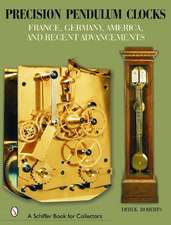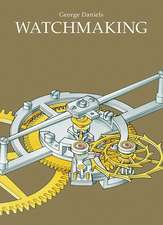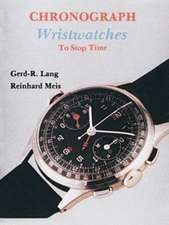tuPOY: Thermally Unstable Partially Oriented Yarns: Silicon of the Future: Advanced Structured Materials, cartea 23
Autor H.D. Mustafa, Sunil H. Karamchandani, Shabbir N. Merchant, Uday B. Desaien Limba Engleză Hardback – 8 dec 2015
The book covers the production process of tuPOY and goes onto conceptual advancement from manipulating the sensing, radiating andprocessingproperties of tuPOY. Theoretical modelling of tuPOY is characterizedby steady-state equations exploiting interchanges based on the latticekinetics, which mathematizes an Interchange Phenomenon intuPOY. The numerical manifestations calibrate mathematically, tuPOY’s responseto any external physical impetus such as charge, heat or energy flow.
The book validates the sensing properties and theoreticalmodel by designing a tuPOY sensor which can be used in a plethora ofapplications. A novel microstrip antenna is designed by amalgamation of tuPOY,raw silk and polynylon composites to experimentally verify the radiationproperties of the new material. The conduction properties are verified by drawingfibres of tuPOY and using them as wires and connectors in electronics. A PowerGenerating Unit (PGU) is designed with tuPOY as its primary element. This is afirst of its kind PGU that scavenges power from thermal energy presenting a newdimension in operational power dynamics.
Overall this book should be of interest to a wide range of readersranging from researchers, scientists, developers, manufacturers, engineers,graduate students and anyone who has satiety to think differently.
| Toate formatele și edițiile | Preț | Express |
|---|---|---|
| Paperback (1) | 376.22 lei 6-8 săpt. | |
| Springer India – 27 mar 2019 | 376.22 lei 6-8 săpt. | |
| Hardback (1) | 383.33 lei 6-8 săpt. | |
| Springer India – 8 dec 2015 | 383.33 lei 6-8 săpt. |
Din seria Advanced Structured Materials
- 18%
 Preț: 949.90 lei
Preț: 949.90 lei - 18%
 Preț: 1011.27 lei
Preț: 1011.27 lei - 18%
 Preț: 1014.28 lei
Preț: 1014.28 lei - 18%
 Preț: 1109.16 lei
Preț: 1109.16 lei - 18%
 Preț: 1034.17 lei
Preț: 1034.17 lei - 15%
 Preț: 713.69 lei
Preț: 713.69 lei - 18%
 Preț: 1007.35 lei
Preț: 1007.35 lei - 18%
 Preț: 899.21 lei
Preț: 899.21 lei - 18%
 Preț: 1116.26 lei
Preț: 1116.26 lei - 18%
 Preț: 1120.99 lei
Preț: 1120.99 lei - 18%
 Preț: 785.55 lei
Preț: 785.55 lei - 18%
 Preț: 894.46 lei
Preț: 894.46 lei - 18%
 Preț: 1222.01 lei
Preț: 1222.01 lei - 18%
 Preț: 993.12 lei
Preț: 993.12 lei - 18%
 Preț: 792.66 lei
Preț: 792.66 lei - 18%
 Preț: 807.64 lei
Preț: 807.64 lei - 18%
 Preț: 1007.35 lei
Preț: 1007.35 lei - 18%
 Preț: 1120.18 lei
Preț: 1120.18 lei - 18%
 Preț: 1233.06 lei
Preț: 1233.06 lei - 18%
 Preț: 748.46 lei
Preț: 748.46 lei - 18%
 Preț: 1106.00 lei
Preț: 1106.00 lei - 18%
 Preț: 753.20 lei
Preț: 753.20 lei - 18%
 Preț: 780.82 lei
Preț: 780.82 lei - 18%
 Preț: 803.40 lei
Preț: 803.40 lei - 18%
 Preț: 798.18 lei
Preț: 798.18 lei - 18%
 Preț: 1123.35 lei
Preț: 1123.35 lei - 18%
 Preț: 901.64 lei
Preț: 901.64 lei - 18%
 Preț: 731.91 lei
Preț: 731.91 lei - 18%
 Preț: 947.04 lei
Preț: 947.04 lei - 15%
 Preț: 643.65 lei
Preț: 643.65 lei - 15%
 Preț: 639.25 lei
Preț: 639.25 lei - 15%
 Preț: 661.65 lei
Preț: 661.65 lei - 18%
 Preț: 953.82 lei
Preț: 953.82 lei - 15%
 Preț: 646.62 lei
Preț: 646.62 lei - 18%
 Preț: 1229.10 lei
Preț: 1229.10 lei - 15%
 Preț: 637.78 lei
Preț: 637.78 lei - 15%
 Preț: 651.84 lei
Preț: 651.84 lei - 15%
 Preț: 641.71 lei
Preț: 641.71 lei - 15%
 Preț: 649.22 lei
Preț: 649.22 lei - 15%
 Preț: 658.70 lei
Preț: 658.70 lei - 5%
 Preț: 719.59 lei
Preț: 719.59 lei - 15%
 Preț: 645.79 lei
Preț: 645.79 lei - 15%
 Preț: 646.43 lei
Preț: 646.43 lei - 18%
 Preț: 936.29 lei
Preț: 936.29 lei - 18%
 Preț: 1231.16 lei
Preț: 1231.16 lei
Preț: 383.33 lei
Nou
Puncte Express: 575
Preț estimativ în valută:
73.35€ • 76.59$ • 60.57£
73.35€ • 76.59$ • 60.57£
Carte tipărită la comandă
Livrare economică 15-29 aprilie
Preluare comenzi: 021 569.72.76
Specificații
ISBN-13: 9788132226307
ISBN-10: 8132226305
Pagini: 73
Ilustrații: XIII, 73 p. 23 illus.
Dimensiuni: 155 x 235 x 13 mm
Greutate: 0.3 kg
Ediția:1st ed. 2016
Editura: Springer India
Colecția Springer
Seria Advanced Structured Materials
Locul publicării:New Delhi, India
ISBN-10: 8132226305
Pagini: 73
Ilustrații: XIII, 73 p. 23 illus.
Dimensiuni: 155 x 235 x 13 mm
Greutate: 0.3 kg
Ediția:1st ed. 2016
Editura: Springer India
Colecția Springer
Seria Advanced Structured Materials
Locul publicării:New Delhi, India
Public țintă
ResearchCuprins
Introduction.- Manufacturing Process of Thermally Unstable Partially Oriented Yarns.- Thermal Unstability Analysis.- tuPOY: Mathematical and Analytical Characterization.- tuPOY as a Radiating Element: Antenna.- Internet of Things and Ubiquitous Sensing: tuPOY in future of Computing.
Notă biografică
H.D. Mustafa has graduated Summa Cum Laude(University Gold Medal) in 2001, from TU, New Orleans, USA with a Double Majorin Computer Science and Computer Engineering and a PhD in ElectricalEngineering. He is the first recipient of the prestigious Chancellor Fellowshipin 1998 for pursuing Undergraduate Education. He is awarded the Honoris Causa,Doctor of Engineering Sciences in May 2015. Currently, he is the PresidentR&D of Transocean Inc. and RIG Ltd. He is a fellow of the ACS and ICCA. Hehas published over 40 journal papers including publications in reputedinternational journals. He was the Associate Editor of Hydrocarbon ProcessingJournal from 2007 to 2009.
He is a Radical and dynamic multidisciplinaryscientist and executive, leading interdisciplinary multibillion dollar R&Dand Industrial projects. A multidisciplinary researcher his interest is notbound to any specific field but spans all domains of engineering and science.He is a strategic visionary and team leader amalgamating institutional andindustrial research and a skilled expert in observing and translating conceptsinto reality, with operational excellence in diverse environments.
H.D. Mustafa is the Chief Inventor of the CrudeOil Quality Improvement (COQI®) technology and concept, which has marketcapitalization of US$ 2.5 Billion as of 2014. He was awarded the MeritRecognition Award by NASA, USA in 2005 and the President of India EMPI Award in2006 by Government of India for his contributions to Research and Development.He was nominated and shortlisted for the prestigious Global Innovator of theYear Award for 2013. In July 2013, H.D. Mustafa achieved a World Record inIndia for the deepest oil exploration using the COQI® process.
Dr. Sunil Karamchandani obtained his doctoratedegree from Department of Electrical Engineering at IIT Bombay in the area ofWireless Body Area Networks (WBAN). His contributions are recognized in NatureIndia,Proceedings of IEEE and generated extensive news coverage with leadingtabloids namely The Financial Express, Hindustan Times and Lokmat. He was atechnical consultant for Blue Star InfoTech providing interactive solutions forsegmentation of abdominal aortic aneurysms in collaboration with BARCO, U.K. Heis twice the recipient of Microsoft Travel Award in 2010 and 2012. Currently heis associated with Department of Electronics and Telecommunication, D. J.Sanghvi college of Engineering, University of Mumbai and is the IDC coordinatorresponsible for development of innovative ideas in association with Departmentof Science & Technology (DST) and National Entrepreneurship Network (NEN).He has over fifty prominent publications in journals and conferences of reputeand authored two books on Applied Mathematics over a teaching carrier spanningmore than ten years. He is an avid international traveler, more recently havingdelivered a talk on “Promising textiles, celebrating the Silicon of the Future”at “Aurel Vlaicu”, University of Arad, Romania.
Shabbir N Merchant received his B. Tech, M. Tech,and PhD degrees all from Department of Electrical Engineering, Indian Instituteof Technology Bombay, India. Currently he is a Professor in Department ofElectrical Engineering at IIT Bombay. He has more than 30 years of experiencein teaching and research. Dr. Merchant has made significant contributions inthe field of signal processing and its applications. His noteworthycontributions have been in solving state of the art signal and image processingproblems faced by Indian defence. His broad area of research interestsarewireless communications, wireless sensor networks, signal processing,multimedia communication, and image processing and has published extensively inthese areas. He is a co-author with his students who have won Best PaperAwards. He has been a chief investigator for a number of sponsored andconsultancy projects. He has served as a consultant to both private industriesand defence organizations. He is a Fellow of IETE. He is a recipient of 10thIETE Prof. S. V. C. Aiya Memorial Award for his contribution in the field ofdetection and tracking. He is also a recipient of 9th IETE SVC Aiya MemorialAward for ‘Excellence in Telecom Education’. He is a winner of the 2013 VASVIKAward in the category of Electrical & Electronic Sciences & Technology.
Uday B. Desai received the B. Tech. degree fromIndian Institute of Technology, Kanpur, India, in 1974, the M.S. degree fromthe State University of New York, Buffalo, in 1976, and the Ph.D. degree fromThe Johns Hopkins University, Baltimore, U.S.A., in 1979, all in ElectricalEngineering. Since June 2009 he is the Director of IIT Hyderabad. From 1979 to1987 he was with the Electrical Engineering Dept. at Washington StateUniversity, Pullman, WA, U.S.A. From 1987 to May 2009 he was a Professor in theElectrical Engineering. Department at the Indian Institute of Technology -Bombay. He has held Visiting Associate Professor's position at Arizona StateUniversity, Purdue University, and Stanford University. He was a visitingProfessor at EPFL, Lausanne during the summer of 2002. From July 2002 to June2004 he was the Director of HP-IITM R and D Lab. at IIT-Madras.<
His research interests are in wirelesscommunication, IoT and statistical signal processing. He is the Editor of thebook "Modeling and Applications of Stochastic Processes" (KluwerAcademic Press, Boston, U.S.A. 1986). He is also a co-author of 4 books dealingwith signal processing and wireless communication.
Dr. Desai is a senior member of IEEE, a Fellow ofINSA (Indian National Science Academy), Fellow of Indian National Academy ofEngineering (INAE). He is on the board of Tata Communications Limited. He wasalso on the Visitation Panel for University of Ghana.
He is a Radical and dynamic multidisciplinaryscientist and executive, leading interdisciplinary multibillion dollar R&Dand Industrial projects. A multidisciplinary researcher his interest is notbound to any specific field but spans all domains of engineering and science.He is a strategic visionary and team leader amalgamating institutional andindustrial research and a skilled expert in observing and translating conceptsinto reality, with operational excellence in diverse environments.
H.D. Mustafa is the Chief Inventor of the CrudeOil Quality Improvement (COQI®) technology and concept, which has marketcapitalization of US$ 2.5 Billion as of 2014. He was awarded the MeritRecognition Award by NASA, USA in 2005 and the President of India EMPI Award in2006 by Government of India for his contributions to Research and Development.He was nominated and shortlisted for the prestigious Global Innovator of theYear Award for 2013. In July 2013, H.D. Mustafa achieved a World Record inIndia for the deepest oil exploration using the COQI® process.
Dr. Sunil Karamchandani obtained his doctoratedegree from Department of Electrical Engineering at IIT Bombay in the area ofWireless Body Area Networks (WBAN). His contributions are recognized in NatureIndia,Proceedings of IEEE and generated extensive news coverage with leadingtabloids namely The Financial Express, Hindustan Times and Lokmat. He was atechnical consultant for Blue Star InfoTech providing interactive solutions forsegmentation of abdominal aortic aneurysms in collaboration with BARCO, U.K. Heis twice the recipient of Microsoft Travel Award in 2010 and 2012. Currently heis associated with Department of Electronics and Telecommunication, D. J.Sanghvi college of Engineering, University of Mumbai and is the IDC coordinatorresponsible for development of innovative ideas in association with Departmentof Science & Technology (DST) and National Entrepreneurship Network (NEN).He has over fifty prominent publications in journals and conferences of reputeand authored two books on Applied Mathematics over a teaching carrier spanningmore than ten years. He is an avid international traveler, more recently havingdelivered a talk on “Promising textiles, celebrating the Silicon of the Future”at “Aurel Vlaicu”, University of Arad, Romania.
Shabbir N Merchant received his B. Tech, M. Tech,and PhD degrees all from Department of Electrical Engineering, Indian Instituteof Technology Bombay, India. Currently he is a Professor in Department ofElectrical Engineering at IIT Bombay. He has more than 30 years of experiencein teaching and research. Dr. Merchant has made significant contributions inthe field of signal processing and its applications. His noteworthycontributions have been in solving state of the art signal and image processingproblems faced by Indian defence. His broad area of research interestsarewireless communications, wireless sensor networks, signal processing,multimedia communication, and image processing and has published extensively inthese areas. He is a co-author with his students who have won Best PaperAwards. He has been a chief investigator for a number of sponsored andconsultancy projects. He has served as a consultant to both private industriesand defence organizations. He is a Fellow of IETE. He is a recipient of 10thIETE Prof. S. V. C. Aiya Memorial Award for his contribution in the field ofdetection and tracking. He is also a recipient of 9th IETE SVC Aiya MemorialAward for ‘Excellence in Telecom Education’. He is a winner of the 2013 VASVIKAward in the category of Electrical & Electronic Sciences & Technology.
Uday B. Desai received the B. Tech. degree fromIndian Institute of Technology, Kanpur, India, in 1974, the M.S. degree fromthe State University of New York, Buffalo, in 1976, and the Ph.D. degree fromThe Johns Hopkins University, Baltimore, U.S.A., in 1979, all in ElectricalEngineering. Since June 2009 he is the Director of IIT Hyderabad. From 1979 to1987 he was with the Electrical Engineering Dept. at Washington StateUniversity, Pullman, WA, U.S.A. From 1987 to May 2009 he was a Professor in theElectrical Engineering. Department at the Indian Institute of Technology -Bombay. He has held Visiting Associate Professor's position at Arizona StateUniversity, Purdue University, and Stanford University. He was a visitingProfessor at EPFL, Lausanne during the summer of 2002. From July 2002 to June2004 he was the Director of HP-IITM R and D Lab. at IIT-Madras.<
His research interests are in wirelesscommunication, IoT and statistical signal processing. He is the Editor of thebook "Modeling and Applications of Stochastic Processes" (KluwerAcademic Press, Boston, U.S.A. 1986). He is also a co-author of 4 books dealingwith signal processing and wireless communication.
Dr. Desai is a senior member of IEEE, a Fellow ofINSA (Indian National Science Academy), Fellow of Indian National Academy ofEngineering (INAE). He is on the board of Tata Communications Limited. He wasalso on the Visitation Panel for University of Ghana.
Textul de pe ultima copertă
This book provides a new direction in electronics researchwith the invention of a new material tuPOY, which changes our perception ofdeveloping electronics. Evolving on a relatively underplayed phenomenon ofstatic electricity in scientific exploration and application, tuPOY upholds thepotential to rival both silicon and metals as electronics of the future.Devices made of tuPOY present a new emblem to the technological world, where wecould envision our electronic paraphernalia from a completely differentperspective. A computer the size of a big wall, which could be neatly foldedand kept in our pockets when not in use and laundered on a regular basis, can beimagined possible with this invention. The concept, manufacturing process,physics and uses of tuPOY as the next generation material of electronics isdescribed in this book.
The book covers the production process of tuPOY and goes onto conceptual advancement from manipulating the sensing, radiating andprocessingproperties of tuPOY. Theoretical modelling of tuPOY is characterizedby steady-state equations exploiting interchanges based on the latticekinetics, which mathematizes an Interchange Phenomenon intuPOY. The numerical manifestations calibrate mathematically, tuPOY’s responseto any external physical impetus such as charge, heat or energy flow.
The book validates the sensing properties and theoreticalmodel by designing a tuPOY sensor which can be used in a plethora ofapplications. A novel microstrip antenna is designed by amalgamation of tuPOY,raw silk and polynylon composites to experimentally verify the radiationproperties of the new material. The conduction properties are verified by drawingfibres of tuPOY and using them as wires and connectors in electronics. A PowerGenerating Unit (PGU) is designed with tuPOY as its primary element. This is afirst of its kind PGU that scavenges power from thermal energy presenting a newdimension in operational power dynamics.
Overall this book should be of interest to a wide range of readersranging from researchers, scientists, developers, manufacturers, engineers,graduate students and anyone who has satiety to think differently.
The book covers the production process of tuPOY and goes onto conceptual advancement from manipulating the sensing, radiating andprocessingproperties of tuPOY. Theoretical modelling of tuPOY is characterizedby steady-state equations exploiting interchanges based on the latticekinetics, which mathematizes an Interchange Phenomenon intuPOY. The numerical manifestations calibrate mathematically, tuPOY’s responseto any external physical impetus such as charge, heat or energy flow.
The book validates the sensing properties and theoreticalmodel by designing a tuPOY sensor which can be used in a plethora ofapplications. A novel microstrip antenna is designed by amalgamation of tuPOY,raw silk and polynylon composites to experimentally verify the radiationproperties of the new material. The conduction properties are verified by drawingfibres of tuPOY and using them as wires and connectors in electronics. A PowerGenerating Unit (PGU) is designed with tuPOY as its primary element. This is afirst of its kind PGU that scavenges power from thermal energy presenting a newdimension in operational power dynamics.
Overall this book should be of interest to a wide range of readersranging from researchers, scientists, developers, manufacturers, engineers,graduate students and anyone who has satiety to think differently.
Caracteristici
Introduces a brand new material that can work as silicon alternative Gives access to the entire structure of tuPOY in one publication No similar books, publications or materials available in the non-metallic domain which emulate the functions of tuPOY tuPOY is classified as the first non-metallic material having properties to replace silicon in the processor manufacturing domain Includes supplementary material: sn.pub/extras













